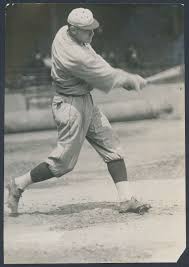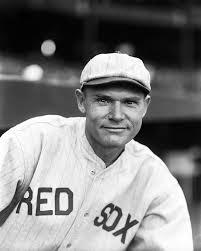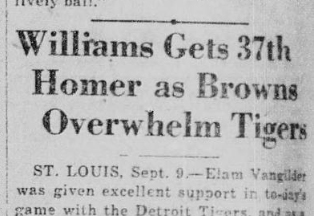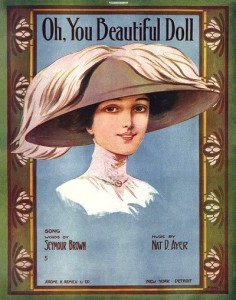Historical Hitter September 9 1922: Baby Doll Jacobson

 On this day William Baby Doll Jacobson of the St. Louis Browns hit three triples and a single going 4 for 5 and leading Brownie hitting barrage of the Detroit Tigers. These three triples were tied for the season high of 3 in 1922. The final score line from this Saturday afternoon contest was Browns 16 – Tigers 0. The three Tigers pitchers were very accommodating to their hosts as this potent Brownie lineup knocked out 20 hits, one home run, five triples, one double and 13 singles. This 1922 season was the Brownies best in Mound City, as they went 93-61 just one game back of the Yankees.
On this day William Baby Doll Jacobson of the St. Louis Browns hit three triples and a single going 4 for 5 and leading Brownie hitting barrage of the Detroit Tigers. These three triples were tied for the season high of 3 in 1922. The final score line from this Saturday afternoon contest was Browns 16 – Tigers 0. The three Tigers pitchers were very accommodating to their hosts as this potent Brownie lineup knocked out 20 hits, one home run, five triples, one double and 13 singles. This 1922 season was the Brownies best in Mound City, as they went 93-61 just one game back of the Yankees.
William “Baby Doll” Jacobson led the way with 4 hits in 5 at bats, and was followed by five of his teammates with 3 hits each, Johnny Tobin, Eddie Foster, Sisler Williams and pitcher Elam Vangilder, who hit a triple and two doubles. Given all the hits, shortstop Wally Gerber and second base Marty McManus, did not get a hit.
 The game featured the continuation of two hitting streaks. Eventual American League Home Run Champion Ken Williams hit his fifth home run in five games, (he would lead the league with 39 and 155 RBIs) and Hall of Famer George Sisler hit in his 38th consecutive game (he hit in 41 that year and batted .420). Given the power of the home run, many newspapers of the time had with Ken Williams’ 37th home run taking the banner.
The game featured the continuation of two hitting streaks. Eventual American League Home Run Champion Ken Williams hit his fifth home run in five games, (he would lead the league with 39 and 155 RBIs) and Hall of Famer George Sisler hit in his 38th consecutive game (he hit in 41 that year and batted .420). Given the power of the home run, many newspapers of the time had with Ken Williams’ 37th home run taking the banner.
 With the lack of media attention to the triple, it shows by 1922 the home run was baseball’s premier individual play. Branch Rickey noted in his little blue book that “the home run craze brought about by Babe Ruth…” would indeed shape the game from the 1920’s until today. This game‘s media coverage shows how the triple has faded to anomaly status rather than a regular part of the offensive strategy.
With the lack of media attention to the triple, it shows by 1922 the home run was baseball’s premier individual play. Branch Rickey noted in his little blue book that “the home run craze brought about by Babe Ruth…” would indeed shape the game from the 1920’s until today. This game‘s media coverage shows how the triple has faded to anomaly status rather than a regular part of the offensive strategy.
The Tigers were not a terrible team that year, finishing four games over .500 and in third place in the AL some 15 GB. They as a team batted .306 that year second only to the Browns who hit a remarkable .310. Ty Cobb was a player manager, and managed to hit a mere .401, second in the AL that year. Detroit’s pitching was next to last with an ERA+ of 91.
Overall, Jacobson played eleven Major League seasons ten of them with the Browns. He split his time with the Tigers, Red Sox, Indians and A’s to round out his career. Initially scouted and signed by John McGraw of the Giants, he was let go in the minors and signed by the Tigers. The Tigers were in a tight pennant race and subsequently traded him for pitcher Big Bill James and $15,000 in 1915. Jacobson had a successful career batting .311 with 94 triples, 83 home runs, and a 112 OPS+. Not known for his speed, his success in center field was a strong arm and constant shifting to adjust to each batter. With such a baseball IQ Jacobson held 13 fielding records at one time. The St. Louis outfield of the 1920’s of Tobin, Jacobson & Williams is one of the best non-hall of Fame outfield trios in baseball. During this era the Browns finished second once and third twice, the best years of the woeful franchise.
 In a 1924 story by F.C. Lane, entitled “The Mingled Fact and Fallacy in ‘Batting Form’” published in the September edition of Baseball Magazine, Jacobson expounded on his theories on the importance of form in batting, and how he had adopted his own style, finding the style that fit him best. And on September 9 1922 such form allowed Baby Doll Jacobson to hit three triples in one game.
In a 1924 story by F.C. Lane, entitled “The Mingled Fact and Fallacy in ‘Batting Form’” published in the September edition of Baseball Magazine, Jacobson expounded on his theories on the importance of form in batting, and how he had adopted his own style, finding the style that fit him best. And on September 9 1922 such form allowed Baby Doll Jacobson to hit three triples in one game.
Jacobson was given his nickname “Baby Doll” while playing in Mobile of the southern association in April 12, 1912. As part of the home opener celebration a band was in the stands and after Jacobson hit a towering home run, the band serenaded their new slugger with a popular song of the day, “Oh You Beautiful Doll.” The next day the Mobile Register reported the event, and the name stuck. It is a rather ironic name since Jacobson was one of biggest ball players of his era, being 6-3 and 215.
Sources:
SABR Bio Project, by Bill Nowlin , http://sabr.org/bioproj/person/a2668210#_edn9
Baseball-alamanac.com
Baseball-refence.com
Retrosheet.org http://www.retrosheet.org/boxesetc/1922/B09090SLA1922.htm
Historic American Newspapers. Lib. of Congress. <http://chroniclingamerica.loc.gov/lccn/sn83030214/1922-09-10/ed-1/seq-16/>
James, Bill, The New Bill James Historical Baseball Abstract, Free Press (2001).

Baby doll Jacobson was my relative on my Fathers side, I just love that story how he got his name! He sure looks like family!